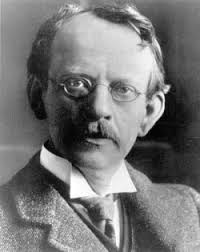J.J. Thomson: Difference between revisions
Ajohnson367 (talk | contribs) No edit summary |
Ajohnson367 (talk | contribs) No edit summary |
||
| Line 3: | Line 3: | ||
==The Main Idea== | ==The Main Idea== | ||
[[File:jj.jpeg]] | [[File:jj.jpeg]] | ||
J. J. Thomson was | J. J. Thomson was a Nobel Prize winning English physicist who used cathode rays to discover electrons. He also developed the mass spectrometer. | ||
===Biography=== | ===Biography=== | ||
J. J. Thomson was born on December 18th, 1856 in England. His father wished he would become an engineer, however he could not find an apprenticeship. He attended Trinity College at Cambridge, and eventually headed the Cavendish Laboratory. Thomson married one of his students, Rose Paget, in 1892. They had two children, Joan and George Thomson. George eventually became a physicist and earned a Nobel Prize of his own. J. J. Thomson published over 200 papers and 13 books. He died on August 30th, 1940 in Cambridge and is buried in Westminster Abbey. | |||
==Electron Discovery== | ==Electron Discovery== | ||
#How is this topic connected to something that you are interested in? | #How is this topic connected to something that you are interested in? | ||
| Line 32: | Line 31: | ||
==References== | ==References== | ||
http://www.chemheritage.org/discover/online-resources/chemistry-in-history/themes/atomic-and-nuclear-structure/thomson.aspx | |||
http://www.biography.com/people/jj-thomson-40039[[Category:Notable Scientists] | |||
[[Category:Notable Scientists] | |||
Revision as of 08:33, 26 November 2015
The Main Idea
 J. J. Thomson was a Nobel Prize winning English physicist who used cathode rays to discover electrons. He also developed the mass spectrometer.
J. J. Thomson was a Nobel Prize winning English physicist who used cathode rays to discover electrons. He also developed the mass spectrometer.
Biography
J. J. Thomson was born on December 18th, 1856 in England. His father wished he would become an engineer, however he could not find an apprenticeship. He attended Trinity College at Cambridge, and eventually headed the Cavendish Laboratory. Thomson married one of his students, Rose Paget, in 1892. They had two children, Joan and George Thomson. George eventually became a physicist and earned a Nobel Prize of his own. J. J. Thomson published over 200 papers and 13 books. He died on August 30th, 1940 in Cambridge and is buried in Westminster Abbey.
Electron Discovery
- How is this topic connected to something that you are interested in?
- How is it connected to your major?
- Is there an interesting industrial application?
Isotopes and Mass Spectrometry
Put this idea in historical context. Give the reader the Who, What, When, Where, and Why.
See also
Are there related topics or categories in this wiki resource for the curious reader to explore? How does this topic fit into that context?
Further reading
Books, Articles or other print media on this topic
External links
Internet resources on this topic
References
http://www.chemheritage.org/discover/online-resources/chemistry-in-history/themes/atomic-and-nuclear-structure/thomson.aspx http://www.biography.com/people/jj-thomson-40039[[Category:Notable Scientists]